Montana Sapphire
An American Gemstone from "The Treasure State"

Photo: Precision and designer cut Montana Sapphires by John Dyer Gems
Did you know that sapphire is also mined in America?
Mines in Montana produce many colors of natural sapphire which is seeing an ever greater popularity for jewelry use. They are especially sought after as an alternative to diamond in engagement rings.
"Montana is the only commercial producer of sapphire in North America. As a result, sapphire was designated as an official Montana state gem in 1969 along with Montana agate. Since Montana sapphire is the only commercially produced sapphire in the United States, some sellers prefer to call it American sapphire.
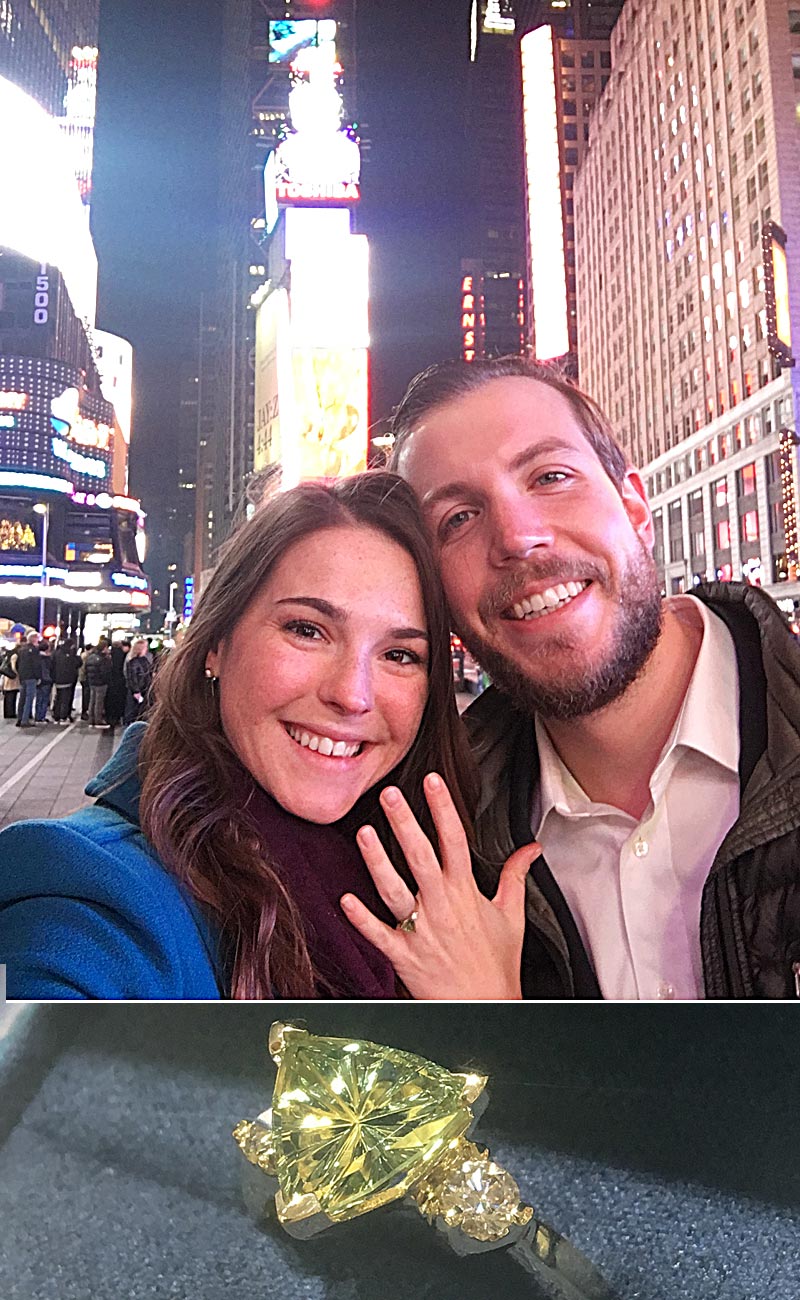
She said yes!
A Montana sapphire engagement story: Demi said "I do" to Adrian in Times Square, NY when he proposed with a ring graced by a natural yellowish green Montana sapphire in our special StarBrite™ trillion cut.
Congratulations to the happy couple!
Photo credits: Client provided engagement and ring photos. Ring made by Select Jewelers, TX.
Sapphires were first discovered in Montana in 1865 by prospectors searching for gold in the gravel bars along the upper Missouri River (Summer 2017 issue of Gems & Gemology). Many of John’s sapphires come from this area, which is about 15 miles north of Helena. Some of them are specifically from the El Dorado Bar deposit.
The first published reference to the sapphires from the Missouri River region was in 1873 in the American Journal of Science by Dr. Lawrence Smith. He stated that “my opinion is that this locality is a far more reliable source for this gem variety of corundum [the mineral name for ruby and sapphire] than any other in the United States that I have yet examined.”
Today several small-scale operations mine sapphire in the Missouri River area. Sapphires from this region generally have a high clarity and various shades of pastel colors. Bluish green and greenish blue are the most common hues but they may also be pink, purple, blue, green, yellow, gray and white (colorless). In order to intensify their light colors, the sapphires are commonly heat treated, but occasionally some of those with a medium tone are of natural color like the parcel of rough and the two Dyer sapphires from El Dorado Bar in the Missouri River region below.
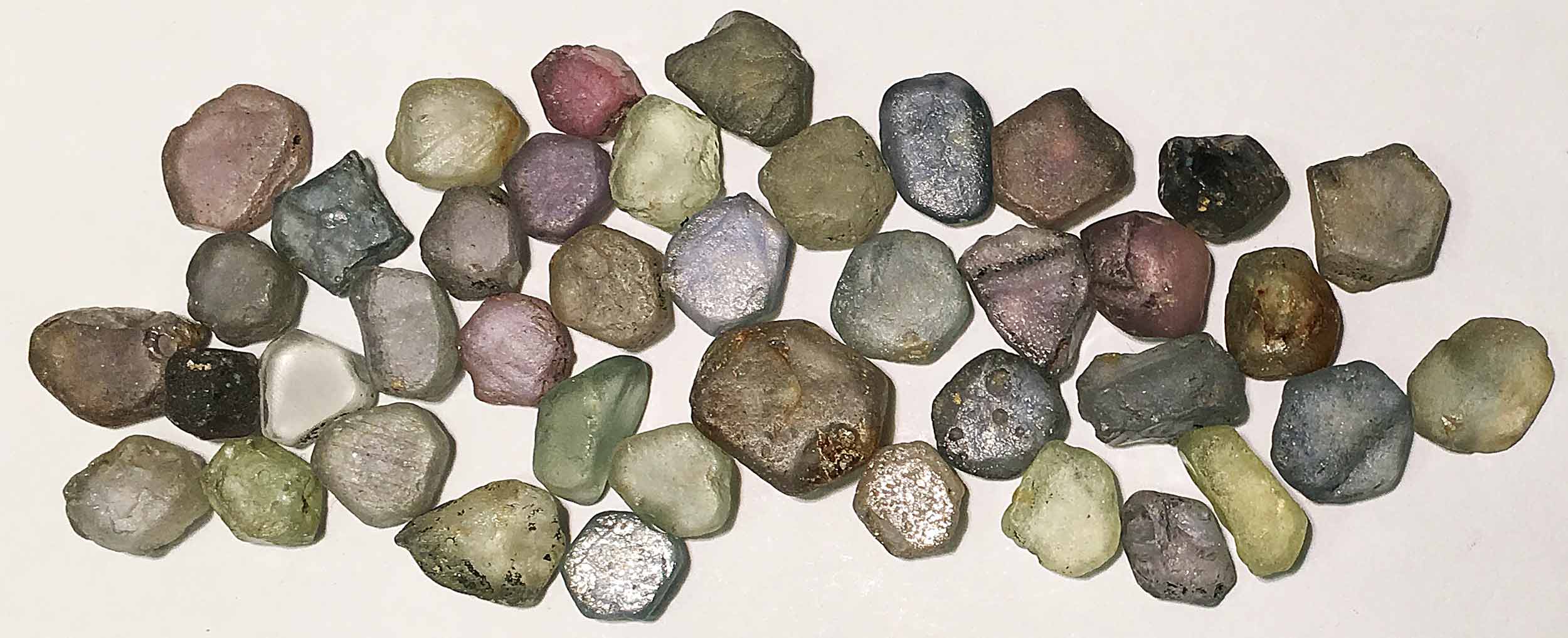
A parcel of natural unheated Montana Sapphire rough crystals from the El Dorado Bar showing some of its range of colors. These raw sapphires are waiting to be ground into their "preformed" shape for cutting. The stronger pink and purple tones in some of the sapphire rough in this picture are unusual for this region.
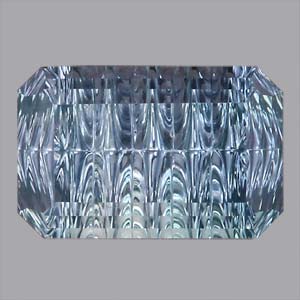
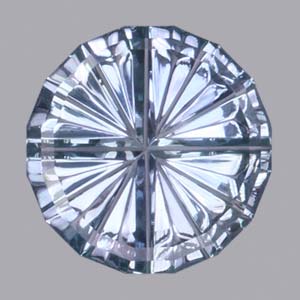
Two natural color Montana sapphires cut by John Dyer & Co. Fine quality creative gem cutting unlocks the potential for beauty that is hidden in the rough sapphires when they are mined. After cutting they are ready for the next step in their journey, being set in a unique piece of sapphire jewelry!
Even though most faceted Missouri River sapphires are in the one-carat range or less, they tend to be significantly larger than those in Yogo Gulch (a.k.a. Yogo), another important mining area.
Yogo is in central Montana about 12 miles southwest of Utica. A gold prospector there named Jake Hoover helped make it famous. A cigar box of Yogo sapphire pebbles he had collected was sent to Tiffany’s in New York in 1895. After examining the stones, their gemologist, George Frederick Kunz, sent Hoover $3,750 along with a letter stating that the stones were sapphires of unusual quality. Afterwards Hoover purchased the land where the sapphires had been found from a sheepherder and later sold it to other investors. It became the highly profitable “English Mine,” which was in operation from 1899 until the 1920s. There have been a few other mining operations since then but today mining activity is largely confined to hobby miners in the area.
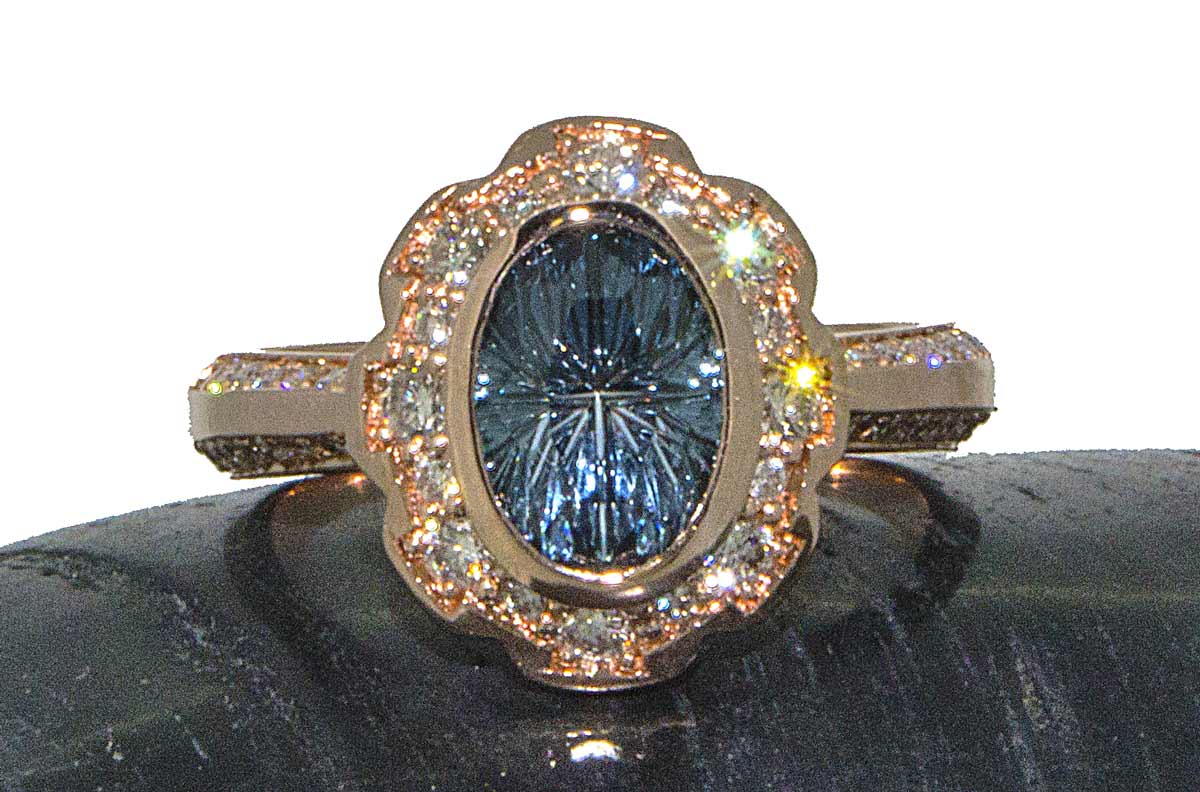
Message from a client:
This is Jan and Jeter Case from J.C. Jewelers in Jackson Hole, Wyoming. We bought a beautiful 2.30 carat natural color Montana sapphire (from the El Dorado Bar region) with your custom StarBrite™ cut back in June. Jeter handcrafted a custom rose gold engagement ring setting with diamond accents for a truly one of a kind piece. Our eldest son proposed with it in Italy and she said yes! She is not really a jewelry girl but thanks to your help she is on her way-she loves her ring! Thank you for helping us find a unique stone to make this the most important (and incredible) ring we have ever made.
We love notes from happy clients like this.
We are also happy to direct you to a jeweler such as Jeter to help make your dream ring once you have selected one of our gems to design the ring around!
The Yogo material is mined from host rock unlike almost all other Montana sapphire which is found in mudflows and riverbed deposits where water no longer runs. Therefore, the mining doesn't muddy the waters of the rivers, and all water used in mining must be desilted in special ponds too before being released or reused at the mine.
Yogo sapphires are noted for their uniform natural strong blue color and high clarity. Most are faceted as round brilliants, but they are rarely larger than a half carat. Their small size makes it hard to economically mine them now, especially with all the regulatory hurdles involved in underground mining in the US. Consequently, the Yogo mines are currently inactive and only the previously mined tailings are being worked.
There is, however, significant commercial mining activity 16 miles southwest of Phillipsburg at Rock Creek, popularly known as Gem Mountain. In terms of concentration and the size of the area, it is Montana’s richest deposit. Rock Creek sapphire crystals are generally pale and may be translucent and often have an irregular distribution of color with a brightly colored spot near the center of the crystal. According to Richard Hughes, author of Ruby & Sapphire: A Gemologists Guide, the most common colors are pale blue, blue-green, green, pink and yellow. Blue or blue-green sapphires with a central orange or yellow spot are also seen allowing them to be multicolor or parti-color when cut, which can result in a fascinating finished gem. Local miners call the bright yellow center the “yolk.” About 90 percent of Rock Creek sapphires are heated to improve their color and transparency. They usually respond better to heat treatment than sapphires from the Missouri River region. In John’s experience, Rock Creek sapphire crystals tend to be smaller and less flat/tabular on average than El Dorado Bar material.
Dry Cottonwood Creek is another area in western Montana where sapphires have been mined. It is 13 air miles north of Butte. Sapphires were discovered there around 1889 and are noted for their high clarity. Like all Montana sapphire, most rough sapphires from Dry Cottonwood Creek will yield a cut gem that weighs less than one carat. Sizes above two carats are rare but stones up to 10 carats have been cut. El Dorado Bar sapphires tend to be some of the largest found in Montana. If you can’t find a large enough Montana sapphire for your needs in John’s inventory, look at John’s sapphires from Australia, Madagascar, Sri Lanka and Tanzania. These countries have a higher percentage of large sapphires than Montana.
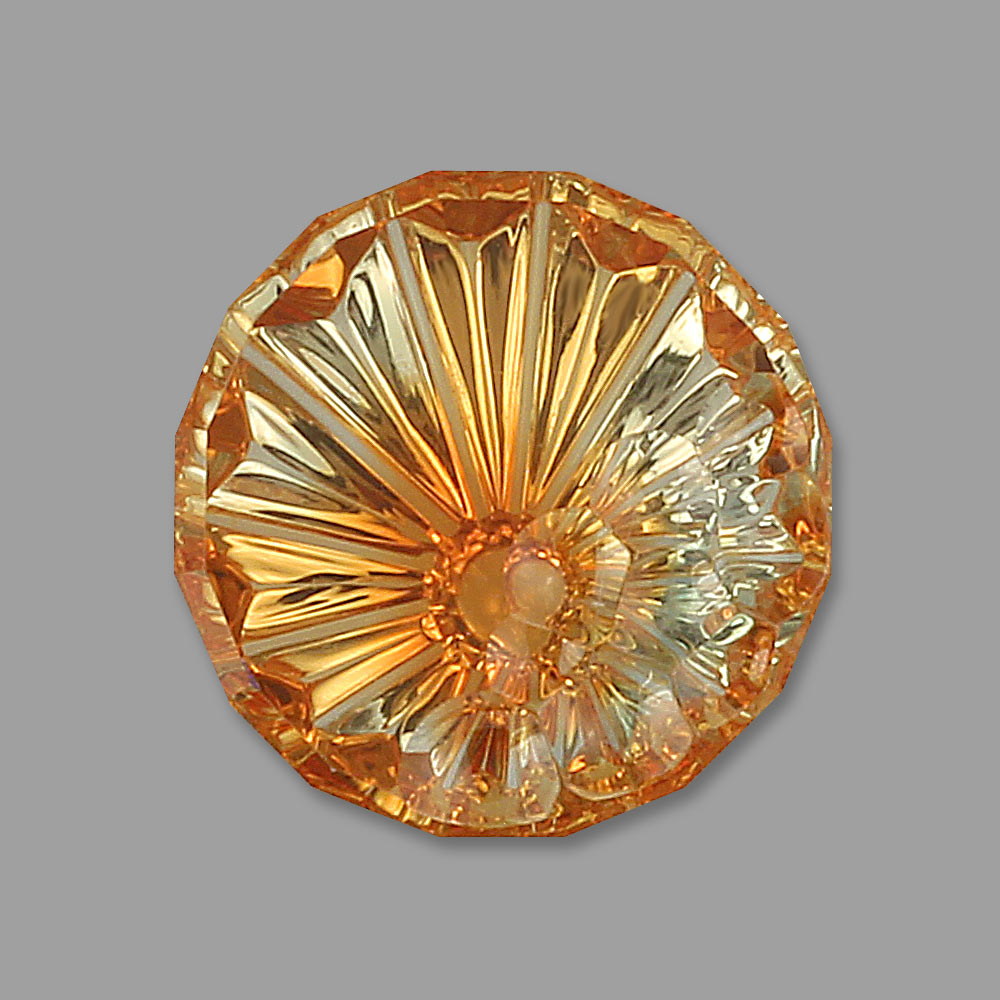
Photo: A rare large size in a Rock Creek sapphire. This gem was crafted into a unique fantasy cut style which looks like the sun coming out from behind clouds. The fantasy cut was specially adapted to this unique rough to take advantage of its shape and other natural characteristics. This gem was heated as almost all sapphires with this strong a color from this location are.
The majority of Dry Cottonwood Creek sapphires are green. Yellow and blue are the next most common hues followed by white, pink, orange and lavender. The gems are often heated to intensify these colors. An example of how heat treatment can improve their color and transparency is shown in these before and after photos of a Dry Cottonwood Creek Montana sapphire from John Dyer.
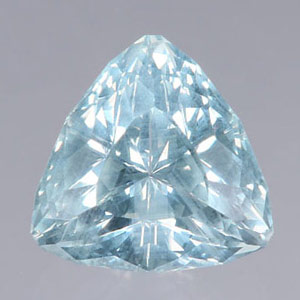
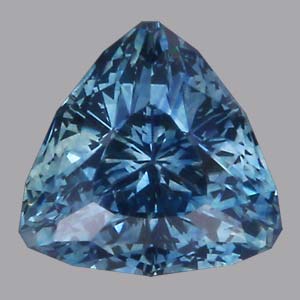
Before and after heating of the same trillion Montana sapphire. Sometimes heating is the best thing that can happen to a specific crystal to bring out its full potential beauty. Before heating, this trillion weighed 1.19cts and had a light color with a hazy appearance due to rutile inclusions. After heating it had a deeper color and less haze but weighed slightly less because it had to be repolished since heating damages the polish.
John also has many unheated sapphires in his inventory. Most are from the Missouri River Region but a few are from Dry Cottonwood Creek or other locations in Montana. Most will have the mining region mentioned in the gem’s description.
John gets a lot of enjoyment from the challenge of making each Montana sapphire crystal into the most beautiful and usable gem he can. In order to do this, he not only studies the shape of the gem but also the clarity, color, transparency, depth and many other characteristics. The combination of all these characteristics of the rough sapphire crystal leads him to choose the shape and cutting style he wants to use to best capture the inherent beauty of the gem. This can lead him to use fantasy cutting styles and freeform shapes, unusual symmetrical shapes such as hexagons, half-moons, pentagons and the like or more standard shapes in a combination of fantasy and traditional faceting techniques or precision flat faceting in some of his popular signature brilliant and radiant styles. Each slight detail of the cut is based on the rough and has a logical reason for it. The way John tailors the cut to the rough while aiming for the most beautiful gem and respecting the individuality of each crystal is part of what sets his gems apart.
(To watch videos on the difference between good cutting and bad cutting and see some of the process of how gems are cut you can visit our video tutorial page here.)
John also considers sapphire’s future use in jewelry during the cutting process. Some of his features that facilitate jewelry use are:
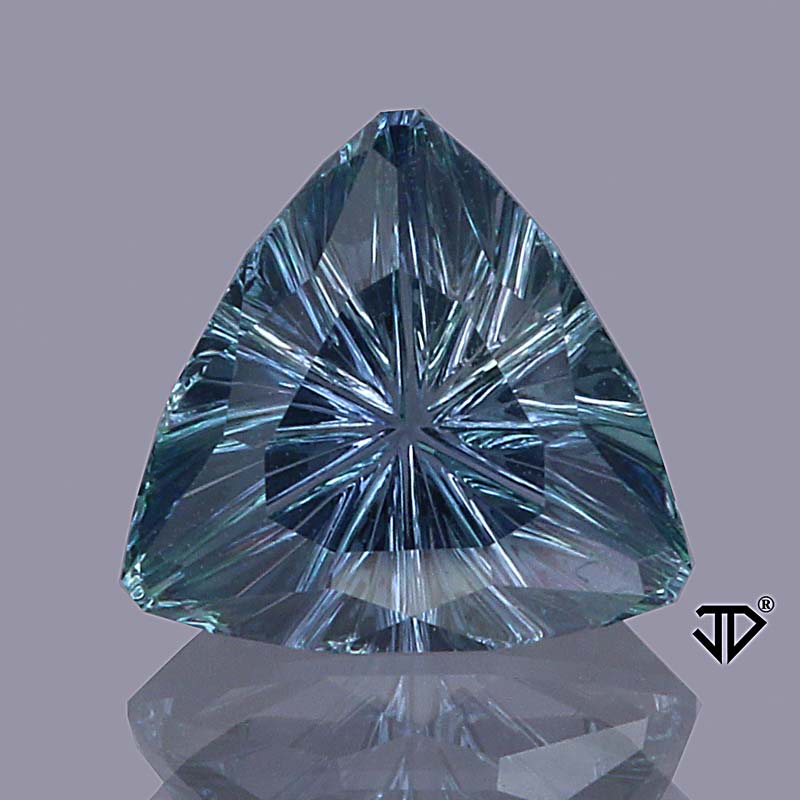
Beauty and practicality:
StarBrite™ cut trillion Montana Sapphire showing the corner facets we put on cuts that would otherwise have sharp corners. These small corners do not take away for the appearance of the gem since they are tiny but they make the gem a lot easier to set in jewelry. This sapphire was set in the engagement ring below!
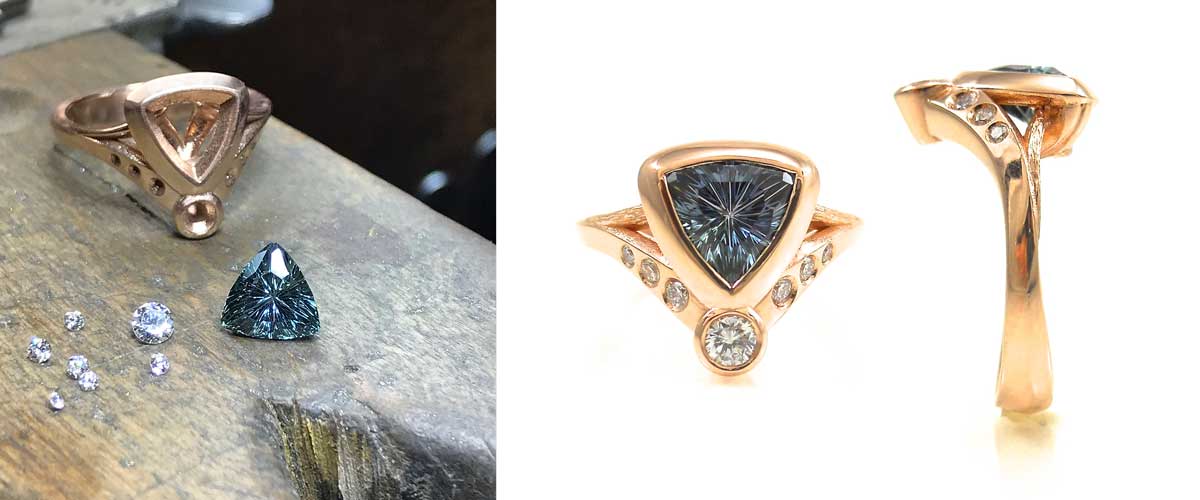
A gem cut with the jewelry designer and goldsmith in mind makes their jobs a lot easier when it comes to making a custom engagement ring like the one shown above.
Photo: Process and finished ring picture courtesy of Wes Anderson of TK Anderson Designs.
· Proper angles on the bottom and top of the gem which facilitate secure setting. Sometimes gemstones have such steep angles that they are very difficult to set, John has a maximum angle he will use so that a gemstone will still be settable. Compare the steep outer pavilion (bottom) angles of the gemstone in the first photo below to those of the gemstone in the second photo with the same cutting style but with Dyer’s MAXIMUM angle. You can see that Dyer’s stone has a more pronounced corner on the end. This will allow it to be set more securely into the seat that is cut into the metal setting. Emerald cuts with steep ends are especially common in tourmalines because they allow the cutter to maximize weight, but steep angles are also sometimes found in fantasy cutting styles from cutters who don’t always take into account how hard this makes it to set a gem.
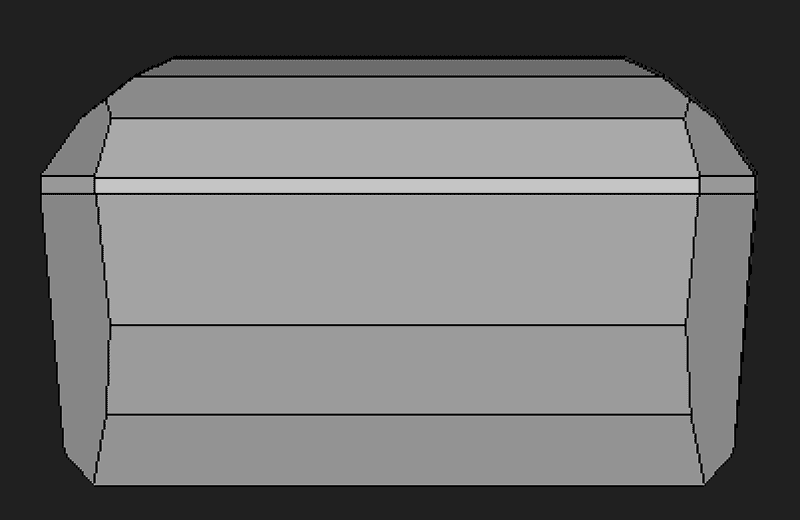
Gem cut with steep ends, these steep angles are common in commercial cutting of tourmaline but also they are more common than it should be even with American cut Fantasy style gemstones. The result is a gem that is hard to grip in the prongs or bezel that is intended to hold it.
Photo: Rendering of a gem cut with steeper ends.
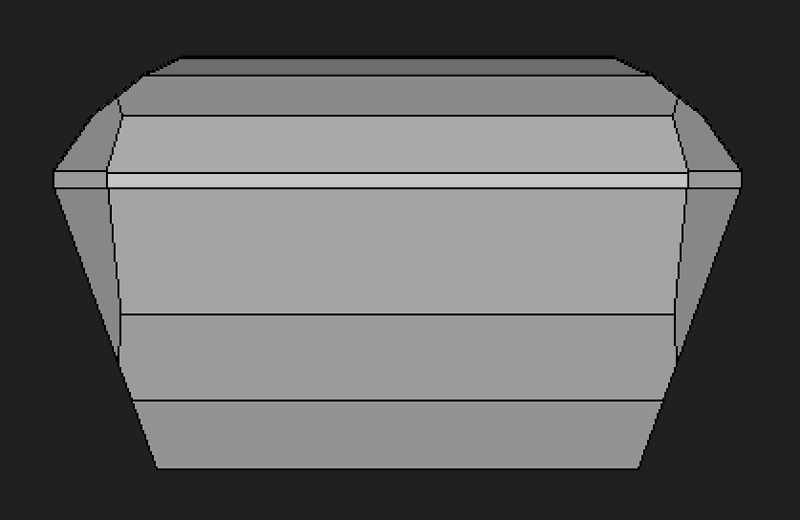
When the cutter chooses to use a maximum angle that still has a corner to it instead of going almost straight down from the girdle it makes the jeweler's life a lot easier.
Photo: Rendering of a cut with our maximum angle.
· An extra row of facets on the sides of the crown along the table to help reduce abrasion by decreasing the sharpness and angle of the edge of the table.
It’s common in fantasy style cuts and also in some other cutting styles to have a very steep angle near the table because it speeds up the cutting process by using fewer facets. However, John opts for either another row of facets or a lower angle on the sides of the crown to keep the edge of the table from being sharp like it is in the image below.

The table and corners of the gemstone in the above image have sharp edges that are more subject to abrasion than those of the gemstone in the image below which has an extra tier of facets along the edge of the table in addition to faceted corners.
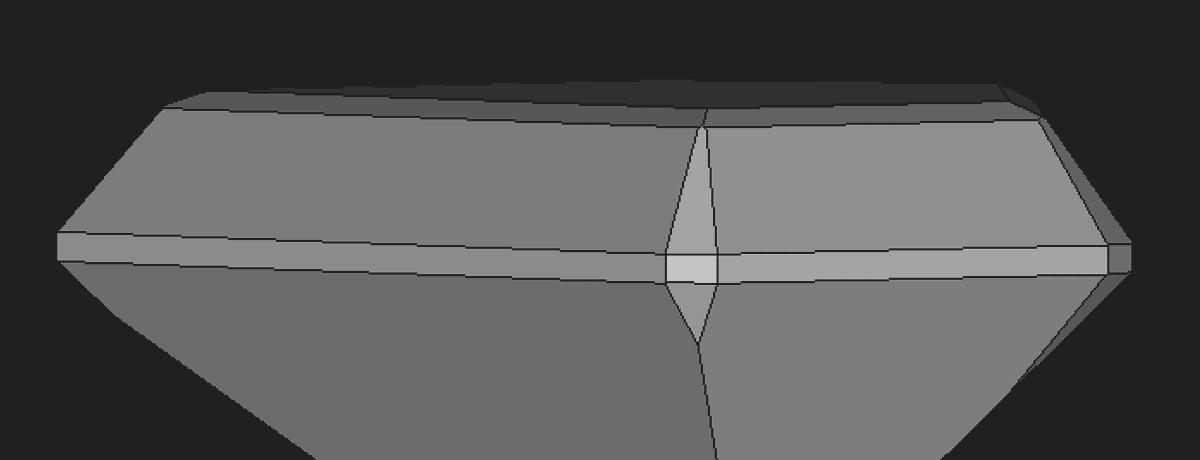
Note the additional facet tier at the top of this gemstone which decreases the crown angle at the table thereby reducing the sharpness of the table edge and its susceptibility to abrasion. The corner facets make the stone easier to set and less likely to chip at the corners. All images by John Dyer.
The above cutting features and many other factors set John’s gemstones apart from a traditional “native cut” or “commercially cut” sapphire.
Ethical Sourcing
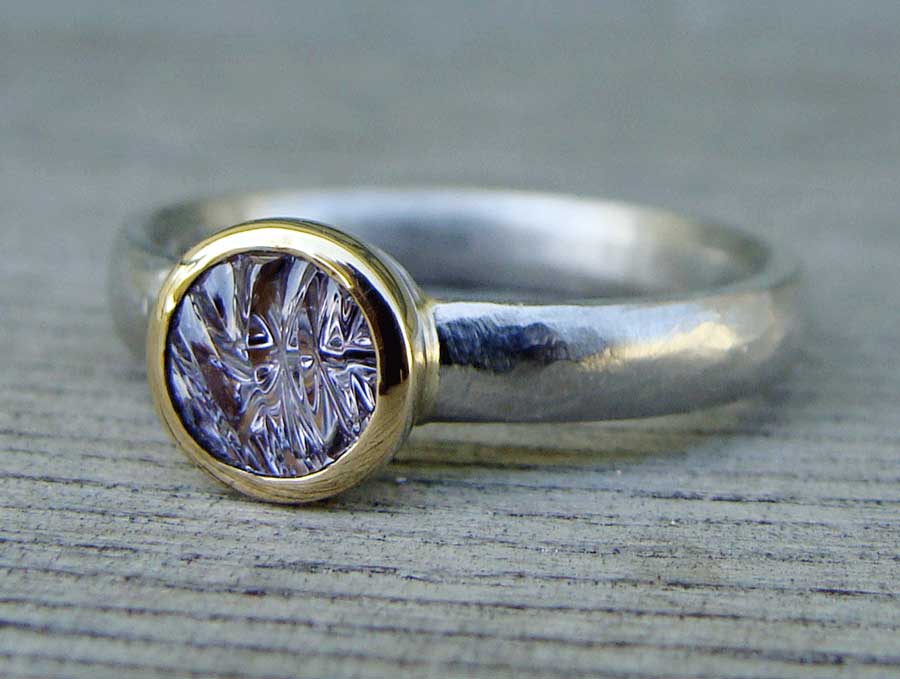
The ethical sourcing aspect of Montana sapphires have made them sought after for making custom engagement rings. Many jewelry designers contact us asking for these gems and then set them for their clients. We love getting the final pictures like the one above of a bezel set round purple Montana sapphire RippleTop™ cut by us in a ring by Tamara McFarland.
Photo: Courtesy Tamara McFarland.
Montana sapphires are an ideal choice if you’re looking for fair trade gems with ethical sourcing because they’re mined in the USA and have a transparent supply chain. All the companies mining in Montana have ... "
https://www.johndyergems.com/montana-sa ... er_COPY_01)